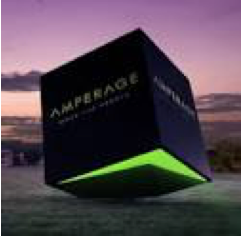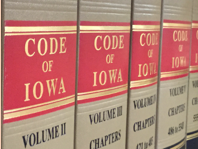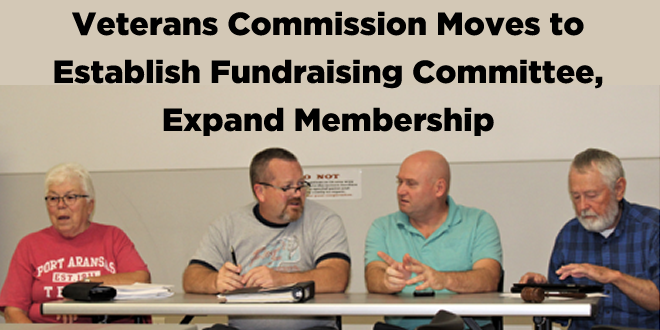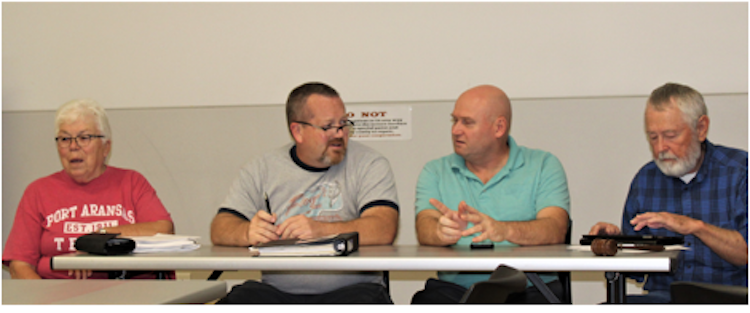By Michael McAllister
At its regular monthly meeting on October 8, Grinnell’s Veterans Memorial Commission took significant steps to enliven the process toward realizing the Prairie Star Artist Residency to be housed in a renovated Veterans Memorial Building.
Four members of the commission were present. Marie Andrews was unable to attend. Nine people made up the audience.
Routine business included adding an agenda item, approving minutes of the previous meeting, approving one bill for payment (Alliant Energy for $102.47), and recording the monthly budget report and the Greater Poweshiek Community Foundation monthly balance as $41,157 and $21,954 respectively.
Completing routine business, the commission considered and advanced three major aspects of the Prairie Star project: fundraising, architecture, and membership.
Fundraising
Fundraising moved forward in two ways, prompted by a capital campaign proposal from  Amperage Marketing & Fundraising, the firm that the commission had contracted for preliminary research and a subsequent proposal.
Amperage Marketing & Fundraising, the firm that the commission had contracted for preliminary research and a subsequent proposal.
At the August meeting, Justin Tolan, Certified Fund Raising Executive representing Amperage, presented the firm’s initial findings. The implementation study had generated the recommendation that the commission scale back its fundraising goal to 1.5 million dollars.
The material now under consideration is Amperage’s step-by-step proposal to enable the commission and its associates to reach that 1.5-million-dollar goal. The plan was included in the October meeting packet.
The cost of the plan totals $92,646 “plus out-of-pocket expenses such as travel, printing and meals,” states the report. The sum is payable in “12 bimonthly installments $7,720.50.”
Commission Vice Chair Randy Hotchkin asked if levy funds can be applied to the cost of the effort. Commission Chair Leo Lease replied that this is a question an attorney is researching; the answer is not available now.
Commission member Terry Stringfellow raised a question about the commission’s obligation to Amperage: Is it necessary to use Amperage now? Could the commission begin fundraising efforts on its own and call on Amperage later if doing so seems necessary?
Tom Lacina pointed out a risk with this strategy. If a major donor is approached unprofessionally and without appropriate supporting materials, that donor might decline involvement.
Lacina also raised the issue of sequence. If Amperage is authorized to initiate its plan, major appeals should align with RDG architects’ building plan projected costs, which he estimates will be available in February.
The commission concluded that it does not want to cut ties with Amperage now, nor does it feel that now is the time to commit fully to the proposal. Therefore, the commission unanimously approved a motion to continue reviewing the Amperage proposal with the intent to enter into an agreement contingent upon the recommendations of the fundraising committee.
Passing that motion led to the need to establish a fundraising committee, which prompted the second of the commission’s advancements in the fundraising aspect of the Prairie Star Artist Residency proposal. As part of its initial research, Amperage Marketing & Fundraising had identified potential fundraisers. The commission unanimously passed a motion to begin contacting these individuals with the intent that the fundraising committee be established and hold its first meeting before the next Veterans Memorial Commission meeting in November.
Architecture
At the June meeting of the Veterans Memorial Commission, members selected RDG  Planning and Design as the architectural firm with whom contract negotiations would proceed. RDG is the design group that planned the extensive renovation of Central Park and has previously submitted plans for renovation of the Veterans Memorial Building.
Planning and Design as the architectural firm with whom contract negotiations would proceed. RDG is the design group that planned the extensive renovation of Central Park and has previously submitted plans for renovation of the Veterans Memorial Building.
At the commission’s July meeting, Tom Lacina presented a brief update, and further considerations about RDG were to be considered at the September meeting. Minutes record that the item was tabled until the October meeting.
Monday night, the commission acknowledged the importance of RDG’s drawings and projections relative to fundraising activities. In short, hard numbers and clear pictures help people envision what they are being asked to support.
As for receiving RDG’s materials, “the sooner the better,” the commission concluded.
Membership
During discussion of agenda item one, “Perfecting and Approval of Agenda,” Leo Lease  called for the addition of one item and members agreed.
called for the addition of one item and members agreed.
That item concerned commission membership and represents at least the potential for significant change in the makeup of Grinnell’s Veterans Memorial Commission. Lease proposed (1) that commission membership be increased from five people to 11, and (2) that the residency requirement, which is now Grinnell, be expanded to include Poweshiek County.
Lease cited three reasons for his proposal. First, a five-member commission can pose problems achieving a quorum. Second, a five-member commission can raise questions about informal visits commission members might have among themselves relative to Iowa’s open meeting statutes. Finally, limiting membership to five and restricting member residency to the city of Grinnell can eliminate talented, dedicated people who sincerely wish to serve.
When Grinnell’s Veterans Memorial Commission was created, the Code of Iowa required that memorial commissions include not more than five people and that the people reside within the town in which the memorial will be or has been placed.
Tom Lacina reported that, circa 1990, Iowa lawmakers changed the code to allow for broadened numerical and geographical membership (likely because commissions began to have problems finding members, he surmised), but Grinnell’s city ordinance has never been revised accordingly.
Lacina also reminded the commission of the state’s gender requirement: that an equal number of male and female members be appointed to commissions to the extent possible.
During the discussion of this motion, Randy Hotchkin questioned the need for 11 members. He pointed out that fielding a five-member commission has not always been easy and that problems achieving a quorum could remain if not worsen. He acknowledged that people who wish to become involved ought to have a way to do so; perhaps serving as chair or member of a subcommittee would be a way for such people to contribute.
Gwen Rieck questioned whether veterans in other areas of Poweshiek County would approach the Prairie Star Residency with the same enthusiasm as Grinnellians, but Lease noted that some people live only a short distance from Grinnell and feel firm allegiance to the town.
The motion was amended to call for a Veterans Memorial Commission of up to11, as opposed to a mandated 11, and to broaden the residency requirement to all of Poweshiek County. The motion passed unanimously.
The request to change the city’s ordinance will be submitted to the city council. Names submitted for membership will need to be approved by Mayor Dan Agnew, from whom the official appointments will come.
One issue was raised during the inquiry portion of the meeting. An audience member suggested that the Veterans Memorial Building—now that a flag flies and is illuminated at night—might be spruced up a bit between now and the time that renovation begins. Peeling paint, for example, could be corrected. Improving the building’s exterior even slightly would enhance public perception, the commenter suggested.
The commission took no action. Volunteer efforts to improve the building’s appearance have raised issues in the past, it was noted. Commission Chair Lease expressed the opinion that all efforts should go toward a fully renovated building with a clear purpose.
By way of comment, Randy Hotchkin presented an example of how art can help revitalize a small community. He referred to Malvern, Iowa, with a population of just over 1,000, located in southwest Iowa about 40 miles to the south and east of Omaha. He learned about art in Malvern from a customer in his barber shop.
Having discussed Grinnell’s Prairie Star Artist Residency proposal with Randy, the customer called it “totally doable,” and he offered Malvern and the Malvern area as an example. Since that visit, Hotchkin has traveled to Malvern and viewed some of the art involved.
The story begins when Zack Jones, a Malvern native but for many years an artist and resident of Arizona, returned to the town. Once there, he moved into a former church, set up an apartment in the basement, started renovating the building, and turned what had been the sanctuary into a permanent sunset—with paint. Today, the building is known as Art Church, a site of diverse community events that draw people to the town and enliven its culture.
In fact, Jones’ work helped spark a revival in Malvern that has produced not only art but also new storefronts and new housing. Omaha World Heraldwriter Erin Grace called the church “a symbol of how vision, elbow grease and a leap of faith can combine to resurrect something old.”
Hotchkin drew a connection to the Prairie Star Artist Residency in that the renovation of the Veterans Memorial Building can benefit Grinnell in much the same way.
As the meeting neared adjournment, Gwen Rieck raised an issue with the date of the next meeting, November 12. Because Veterans Day, November 11, falls on a Sunday this year, some traditional area activities may take place on Monday. Therefore, ironically, some commission members may have conflicts with the regular meeting date of the second Monday of the month.
After discussion, the commission elected to hold the November meeting one week later than usual, on November 19. Although this date is also when the city council will meet for the second time in November, because the commission meets at 5:15 p.m. and the council meets at 7:00 p.m., individuals who wish to attend both meetings should be able to do so.






